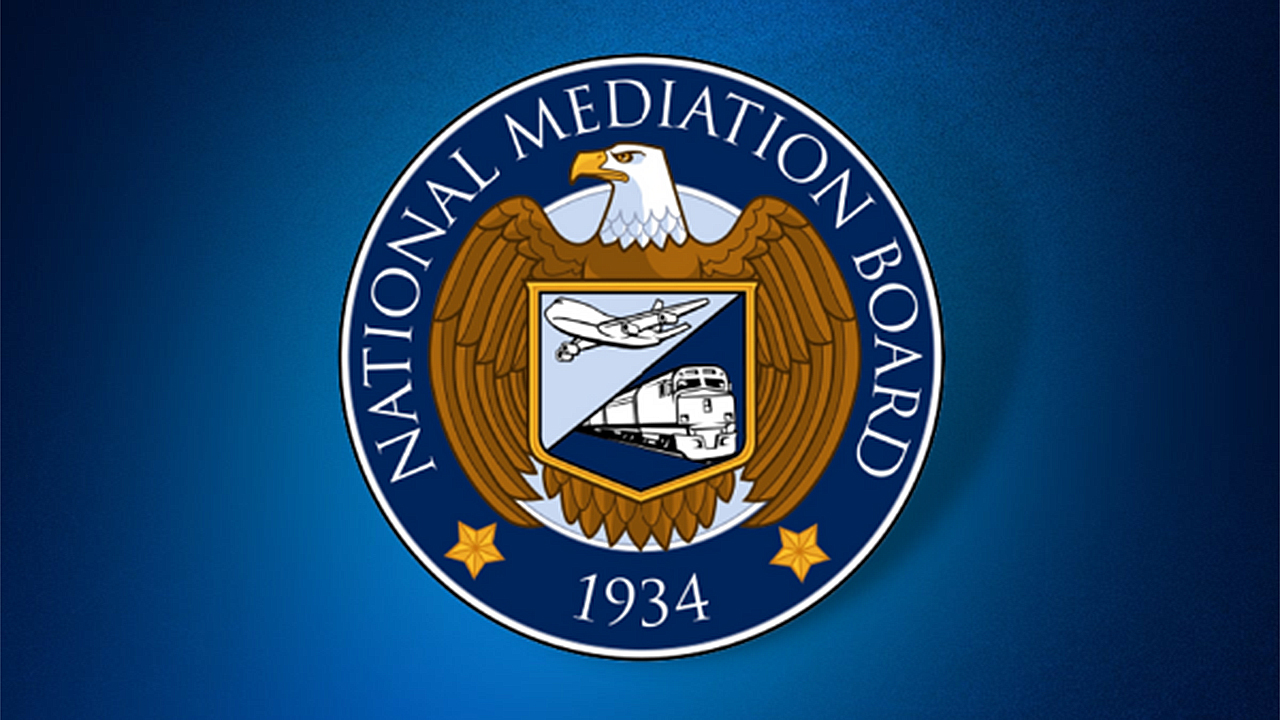
Pressure on NMB to Keep Sides Bargaining
Written by Frank N. Wilner, Capitol Hill Contributing Editor
As the Surface Transportation Board (STB), Federal Maritime Commission and Department of Transportation struggle to ease a problematic supply chain crisis, pressure is mounting on the National Mediation Board (NMB) to prevent a nationwide railroad work stoppage by guiding rail labor and management to a voluntarily negotiated agreement to amend union-member wages, benefits and work rules.
Significantly U.S. military readiness also would be degraded by a rail work stoppage, as railroads are vital to moving heavy weaponry and supplies to ports.
In furtherance of its mission to “help maintain the flow of interstate commerce,” the NMB last week summoned rail union chiefs and rail management labor negotiators to Washington D.C. for a rare three-day mediation session led by all three NMB members. They are Democrat Linda Puchala, a former president of the Association of Flight Attendants and once an NMB mediator; Democrat Deirdre Hamilton, a former Teamsters Union attorney; and Republican Gerald W. Fauth III, a former STB chief of staff and long-time rail shipper consultant. The three-day session was rare in that mediation sessions typically are conducted by NMB staff mediators.
Although the NMB has imposed a gag order on those attending the mediation sessions, Puchala, Hamilton and Fauth signaled their commitment to achieving a voluntary settlement by ordering the parties to return Tuesday, May 31, for further mediation. The contract talks affect some 115,000 rail workers.
Labor/management agreements negotiated under provisions of the Railway Labor Act (RLA) never expire, but are periodically amended, with agreed-to wage increases retroactive to the start of negotiations. This allows the NMB to hold the parties at the bargaining table indefinitely to assure both sides are making good-faith efforts at compromise—the lifeblood of successful arms-length negotiations.
This round of bargaining to amend national agreements affecting 12 rail labor unions, all Class I railroads and many smaller ones began in January 2020. The unions, alleging no progress toward a voluntary settlement—notwithstanding that NMB guided mediation involving 10 of those unions began barely two months ago in late March 2022—have demanded the NMB declare a bargaining impasse.
Were the NMB to agree and declare a bargaining impasse, a 90-day clock would commence ticking toward a nationwide rail shutdown occurring just as lawmakers begin in earnest post-Labor Day reelection campaigns.
NMB precedent is to avoid election-year drama, and therein lies the rub facing the three-member NMB: Does it acquiesce to rail labor demands and create a political drama ahead of November congressional elections? If the NMB does acquiesce, Congress could be forced to take sides, as will be explained. An alternative historically preferred by the NMB is to keep the parties at the bargaining table during election years.
If and when the NMB declares a bargaining impasse, the first step is to offer the parties binding arbitration, which is rarely accepted by both sides. In fact, if both sides were agreeable to binding arbitration, it could already have begun, and labor would not be seeking that a bargaining impasse be declared.
Were either side to reject an offer of binding arbitration, the second step is a White House option to appoint a three-member Presidential Emergency Board (PEB), consisting of three experienced labor arbitrators to hear factual arguments from both sides and make non-binding settlement recommendations. This White House option to appoint a PEB is almost foreordained, as failure to do so allows for a premature work stoppage contrary to the RLA’s objective of being a manual of labor/management peace rather than war.
If PEB recommendations are rejected by either side—and at that point the 90-day clock, containing three separate 30-day cooling off periods, would have expired—the RLA has run its course and labor is free to strike or management to lock out, either creating a nationwide rail shutdown.
How long might a nationwide rail shutdown last? That period is indeterminant. It would be up to Congress to act with back-to-work legislation that could order bargaining to resume, impose the previously non-binding recommendations of the PEB, or be creative and impose congressionally determined contract amendments affecting wages, benefits and work rules. Even short nationwide rail work stoppages in the past have played havoc with America’s supply chain and defense readiness.
Were congressional lawmakers forced to take labor or management sides shortly before voters head to the polls in November, any number of unanticipated negative results loom, including a maverick Senator prolonging an economy-damaging work stoppage through a filibuster. In labor parlance, a “trick bag” awaits those unable to voluntarily reach agreement.
Indeed, history is replete with examples of each side regretting being tossed into a hostile briar patch whose outcome is decided by a third party largely ignorant of the facts and bargaining history. Adding to current uncertainty is that there has not been a nationwide rail work stoppage for more than three decades, meaning but a handful of current lawmakers and their staffs have a working knowledge of what to do when the RLA has run its course.
In fact, that 1991 work stoppage—despite there being at the time a congressional Democratic majority—ended poorly for labor, whose staunchest ally, the late Sen. Ted Kennedy (D-Mass.), voted with the majority against labor’s interests, calling his vote “good for business, good for the economy and good for the nation.” In the House, all Democrats on the House Railroad Subcommittee then voted against labor interests, with the carrier-favorable bill passing on the House floor, 400-5.
That is why former NMB member Robert O. Harris—a Democrat who later served on Presidential Emergency Boards appointed by Presidents Reagan and Clinton—warned that fateful year that failing to make voluntary agreements subjects both parties to “the oldest established permanent floating craps game in Washington”—third-party intervention and decision making whose outcome is difficult, if not impossible, to predict.
So, how far apart are labor and management in this round of bargaining?
To put the numbers in context, train and engine workers (T&E), for example—locomotive engineers and conductors—currently earn just under $100,000 in wages annually (excluding the value of benefits such as healthcare insurance), according to data submitted to the STB by the Association of American Railroads. By comparison, firefighters—considered essential workers during periods of emergency—average less than $60,000 in annual wages, reports the Bureau of Labor Statistics (BLS).
The latest labor proposal—prior to last week’s three-day mediation session—was for wage hikes exceeding 47% through July 1, 2025, and retroactive to January 2020. Labor also seeks an annual Consumer Price Inflation adjustment, a 15% pay differential when “essential employees” must report to work, and a $5,000 signing bonus that could bring the total wage increase to more than 60% by mid-2025. That would be more than $160,000 per T&E employee, excluding the value of benefits.
The carriers’ initial offer was a wage boost of 15% through July 2024, but that may already have been amended upward during last week’s mediation session. The Consumer Price Index (CPI), for example, increased by 8.5% for the 12 months ending in March 2022, reported the BLS. Consumer price inflation in 2020 and 2021 was considerably lower—1.5% for the 12 months ending in March 2020, and 2.6% for the 12 months ending in March 2021.
As for benefits, unionized rail workers currently pay $228.89 monthly toward their health care insurance—about 12% of the plan’s cost to carriers—regardless of family size. By contrast, employees in most other industries contribute almost 30% of a plan’s cost, or $457 monthly on average. Federal government workers pay even more—$574.13 monthly for family coverage, reports the Office of Personnel Management. Those non-railroad plans are tiered, in that employees pay higher monthly contributions toward healthcare as family size increases.
Rail labor seeks to freeze the employee contribution at $228.89 monthly, while carriers are seeking an increase to where the employee contribution would increase from 12% of the plan’s cost to 18%, with tiers added so that employees with a family pay more than those, for example, without a spouse on the plan.
Notably, carriers also shoulder significant other costs per employee. Carriers contribute a maximum of some $5,400 annually toward Tier I of Railroad Retirement coverage; a maximum of some $8,800 annually toward Tier II coverage; another $1,500 annually for Medicare coverage, and some $650 annually for unemployment insurance.
Holding the parties in NMB-guided mediation to achieve a voluntary settlement—as opposed to a third party making an unpredictable decision—is smart strategy, with negotiators of all stripes typically agreeing that the best deals are those negotiated by the parties themselves.
(Progressing in separate negotiations on a carrier-by-carrier basis is a proposal by carriers to reduce train-crew size—from two to one—where compatible with safe operation. Conductors would be redeployed from the cab of the locomotive to ground-based positions. These negotiations are expected to continue into 2023.)

Railway Age Capitol Hill Contributing Editor Frank N. Wilner is author of “Understanding the Railway Labor Act,” published by Railway Age sister company Simmons-Boardman Books in Omaha, Neb.



